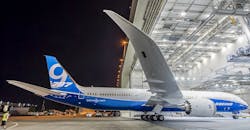Boeing Commercial Airplanes has struck an agreement with Mitsubishi Heavy Industries Ltd. to reduce productions costs for the composite-material wings for the 787 Dreamliner, for which MHI is the sole manufacturer. According to Boeing’s announcement of the agreement, the improvements will center on increased efficiency for MHI’s production methods and supply-chain management, including Lean processes and greater application of automation, among other steps.
The 787 Dreamliner is a wide-body twin-engine aircraft with long range and carrying capacity for 210 to 330 passengers. Boeing calls the Dreamliner its most fuel-efficient commercial jet, with a structure based on a large volume of composite materials helping to reduce fuel consumption by up to 20% versus similar-size aircraft. More than 600 Dreamliners have been delivered to date, and Boeing is on track to increase production from 12 to 14 jets/month by 2019, in order to complete the nearly 1,300 jets that are still to be delivered.
Boeing emphasized the cost-saving efforts were in line with its organization-wide cost-saving efforts.
The agreement also sets plans for the two companies to jointly study advanced aerostructure technologies for future commercial aircraft programs.
"This agreement advances the strong relationship between Boeing and MHI through joint efforts to reduce cost and improve efficiency, with a focus on MHI's production for the 787 Dreamliner," stated Commercial Airplanes president and CEO Kevin McAllister. "Collaboration with suppliers is at the heart of our Partnering for Success efforts, positioning our companies to win in today's competitive marketplace and look ahead to future opportunities."
In addition to assembling the wing structures, MHI also produces the composite materials and components for the wings.
Boeing noted its annual procurement total from Japanese manufacturers is approximately $5 billion, in goods and services, for all of its commercial aircraft and defense programs.
Mitsubishi Heavy Industries manufactures the composite structures at its plant in Nagoya, Japan. The company also manufactures fuselage sections for the Boeing 767, 777 and 777X programs.
About the Author
Robert Brooks
Content Director
Robert Brooks has been a business-to-business reporter, writer, editor, and columnist for more than 20 years, specializing in the primary metal and basic manufacturing industries.
